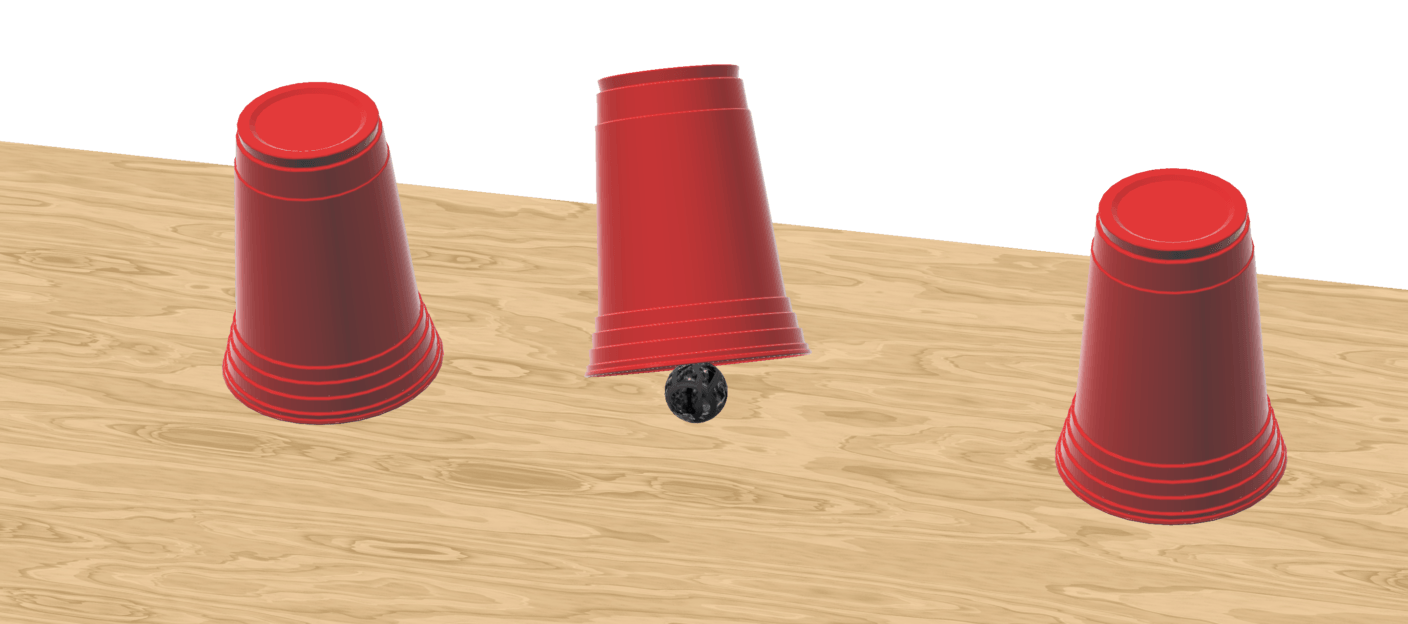End-to-end product traceability- an enabler for future growth
by Markus Ranta • 10 min read
Many of us have witnessed shell game played in crowded tourist streets. Three or more identical cups are placed face down on a surface. A small ball is placed in one so it cannot be seen. Cups are shuffled and the player guesses the cup where the ball is at the end. When product end-to-end traceability is not available, it can be similar guesswork too. Ball drops during the process. You have no idea how the original requirements have been translated into customer’s product.

Understand exactly what was delivered, ability to simulate the exact product configuration even after delivery, identify discrepancies against target values, connect IoT data with accurate product data and simulation models. These are just some of the things that you are missing if you do not have your end-to-end product lifecycle in control. Matti Sommarberg published a good research on Digitalization as a Paradigm Changer in Machine-Building Industry back in 2016. You might also recall his presentation at our customer event in 2020. Research identified Big Data and Artificial Intelligence as the most prominent digital technologies to enable disruption. Well defined end-to-end product traceability forms a basis for many of the identified topics.
This blog concentrates on methods for producing and accurate end-to-end traceability for a product. It also highlights topics to derive value out of that for future growth. Main focus is on a variable modular product in discrete manufacturing. Same methods can, however, also be used in a variety of businesses.
Builiding blocks for successfull product traceability
Product lifecycle of a variable product includes multiple disciplines and maturity states. Multiple disciplines define the different aspects and connect using a so-called digital thread. Multiple maturity states describe an exact product definition for a customer delivery at any given point of time.
Following figure illustrates the full product lifecycle used as framework for this blog.
Starting to build End-to-end traceability
Ideas, innovations, and customer voice are basis for product definition. They are collected and formulated into requirements, functions and systems via a model-based systems engineering (MBSE) approach. In this early phase, Product configuration aspects are considered and used to drive product definition. In MBSE definitions, measurable parameters for each item are included, which are used to simulate predicted performance in 1D. If you want to learn more, see what my colleagues have to say about MBSE.
When detailed design phase starts, a wealth of information is already available through the MBSE approach. This all gets connected to the created detailed definition along with refined product configuration definitions. An important aspect that gets produced during this phase is the 3D definition. It is, after all used throughout the rest of the process. Detailed design also includes 3D simulation model. They validate both the detailed design as well as the previously created 1D simulations.
Going beyond design, towards manufacturing and service
Using a so-called “shift left paradigm”, preparation work can start before the product definition is finalized. This applies specially to manufacturing and service. The work gets done gradually as data maturity increases and gets completed when final maturity is reached. Created 3D models are used to plan and visualize manufacturing and service operations.
It is important to make sure the traceability from the design to manufacturing and service is consistent. This may sound trivial but can be quite tricky. Think of the number of wires behind your home theater receiver. At some point you just need to follow a wire to see where it goes. Same can happen with the product definition if you don’t have a good system to support the process.
You can see this illustrated in below figure where we use traceability and assignments between structures as the digital tread. We have specifically highlighted a part in EBOM (filled red) that has the quantity of two. This can be a component for which it is important to understand the serial number in each of its usages. For example, a bearing at motor end vs free end. Each of those can be installed at different manufacturing operation. For this reason, it is imperative to have the full traceability to understand the exact final product definition. Notice that below example includes Product BOP, Plant BOP and BOE. These aren’t necessary for every implementation, but they’re here to give you an idea.
Other products contributing to your benefit
Products are never developed in isolation without reusing components or modules from other products or from the suppliers. Reusing existing tried and true parts is highly beneficial. At the same time, it also means that parts of the product can get changed. This can happen even during new product development. They can be used in completely different usage scenarios as part of the other products. This needs to be considered in validation and eventually make products more resilient. It also brings complexity in data management and traceability. Proper change management has a crucial role here. It makes sure all implications are understood, change is properly controlled, and necessary people informed. We will be posting a blog about change management later this year. Make sure you follow https://www.linkedin.com/company/idealgrp and as we are now part of Eviden, also https://lnkd.in/eKi8J8CT to not miss any updates.
First run using the traceabilitY
When product definition is released, products can be produced from it. 150% product definition is configured down to a 100% definition by applying configuration rules that match the customer request. During sales phase, this can be used to generate an exact digital twin for the customer quote. When an order is placed, this is used to generate the order specific configuration. Configuration applies to the whole product definition, not only the design. Exact manufacturing operations including required tools and resources are configured. Similarly, exact software that needs to be flashed to the product is available. Configuration even extends to service plans and configuration specific customer documentation. If you want to learn more about configuration, you should take a look at a recent blog post by my colleague on Tackling the 3 primary drivers of product variability.
The 100% definition is used to generate an “occurrence exact” As-Built representation of the delivered product. At first it does not contain serial or lot numbers, but just placeholders based on the EBOM. Manufacturing will populate the serial and lot parts in their right positions (occurrences). To do that, connections between manufacturing operation and EBOM are used. They identify each occurrence and assign their serial or lot number. (Dotted arrow in the below diagram). Remember the bearing example from above?
All the relevant test documents are linked to the As-Built definition which follows the product until the end of life. Manufacturing also introduces variability as alternate, or substitute parts or differing revisions can be used in the production process. Knowing the exact part revision that got installed is crucial for future. Performing this process correctly means that the As-Built product will be connected to the exact correct design revisions and occurrences. As-Built also references the 3D representation, simulation models and has full traceability all the way to the original requirements.
Product is operational – This is where the magic happens
Now the first product from the definition is delivered. This means we start to get our first real life experience on its use out in the field. Experience can come through customer or service and ever more often through IoT connectivity. Full “occurrence exact” traceability removes the guesswork from the equation. We can be confident that we know exactly how to connect this data with the product definition.
Combining the measured data with the product definitions and utilizing simulations created earlier, we create knowledge about the product performance. We understand how different environmental conditions or different product context for a reused module affect its performance. Should there be discrepancies, we now have a solid base of connected and refined data to start analyzing the reasons. We can do informed decisions on how to go ahead with product improvements. Those can be related to our specific product or even the overarching modules. Accuracy of the simulation models get verified and corrected to be better aligned with the measured performance. This enables more refined basis for future product development.
Next runs utilizing existing end-to-end traceability
From this point onwards the product matures through learning. Each delivered product tells its story and stories collected together becomes a basis for new product improvements. They improve both the future products but also the ones on the field already. We see which configurations work, where improvements are needed, and how different environmental conditions affect them. The end-to-end product traceability is available through the digital thread.
Time for Service – Traceability into use
When it is time to service a product, we know exactly what product is coming into service. We know what to expect and how it has been performing. Performance can be compared against the simulation model to see if there are discrepancies. We have access to the As-Built testing documentation. We understand the full history of a physical part. Additionally, we have the exact service plans available for the exact product configuration. This enables prepare for upcoming service and provides immense value for the customer. Additionally, we pass valuable information back to the product definition process from the serviced product.
Final Thoughts on end-to-end product traceability
Creating end-to-end traceability for your products will create a solid base on which all subsequent developments can be based. It is possible with modern tools, however an interplay with PLM and ERP is needed, and often also MES. In configurable products, where components are reused and things are always changing, it can be especially tricky but rewarding.
Upsides speak for themselves. End-to-end product traceability will enable you to position yourself better in future competition. We know that products change, business models change, and global competition places increasing demands on product performance, quality and features. Doing things right will enable you to be the one who disrupts.
“I’m interested, can we start this immediately?”
Sure, we can. Please contact us. Together we see where exactly your most critical pain points are and where the most value is. After that game is on.
More posts

Metso aiming to improve supply chain collaboration through system simulation
Webinar (THIS WEBINAR WILL BE HELD IN FINNISH LANGUAGE) (Material will be distributed in English) August 22, 2023 – 09:00 CET Learn how Metso utilizes system simulation in their hydraulic system design. Research engineer Jesse Backman shares his learning path to system simulation, and how Metso could improve the collaboration of the supply chain through […]

Metso pyrkii kehittämään toimittajayhteistyötä systeemisimuloinnin avulla
Webinaari 22.8.2023 – 10:00 EET Tule kuulemaan kuinka Metso hyödyntää systeemisimulointia hydraulijärjestelmien suunnittelussa. Tutkimusinsinööri Jesse Backman kertoo oppipolkunsa systeemisimuloinnin pariin ja kuinka Metso voisi kehittää yhteistyötä toimittajaketjussaan systeemisimuloinin avulla. Tärkeimmät opit esitellään käytännön suunnitteluesimerkin avulla. Kuinka parantaa yhteistyötä toimitusketjussa systeemisimuloinnin avulla? Mitä systeemisimulointi on? Systeemisimulointi yhdistää yksittäisten komponenttien ominaisuudet ja vuorovaikutukset koko järjestelmän dynaamiseksi käyttäytymiseksi. […]

From Chaos to Clarity: Embracing Modularity
by Olli Uuttu • 8 min read Dear reader, have you ever wondered what goes into building a truly modular product? It’s not as easy as it may seem. While there are several proven methods available to plan and implement optimal modular architectures, it still takes effort, dedication, and discipline to succeed. I’m sure you […]